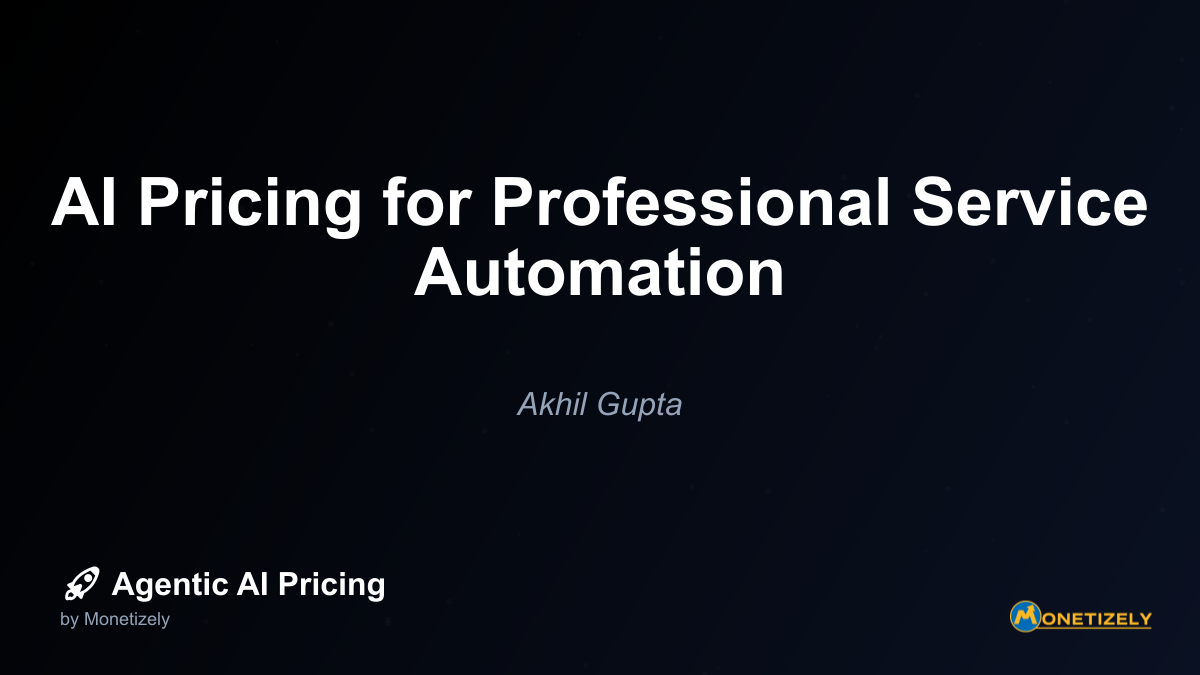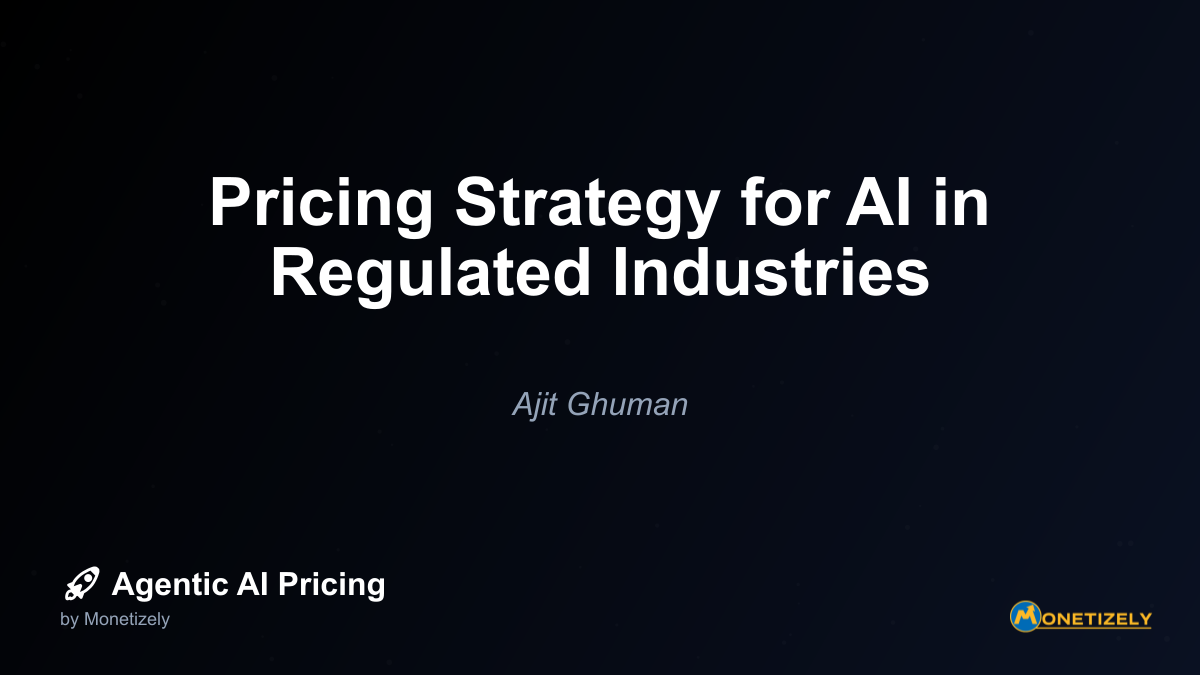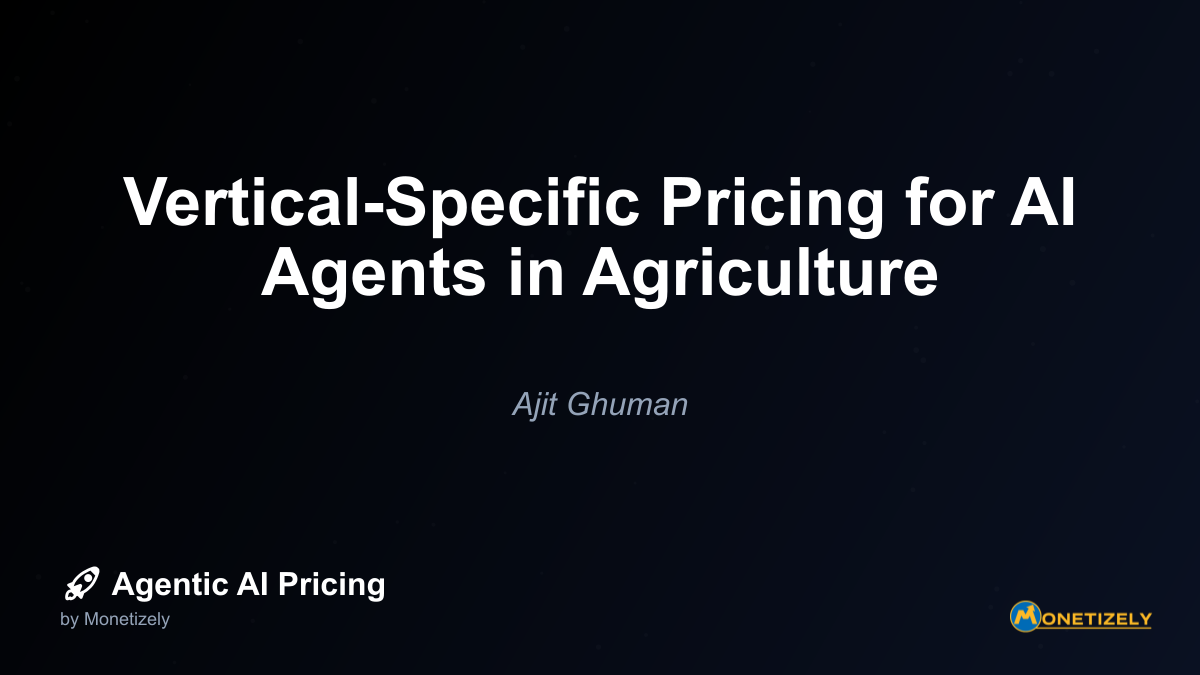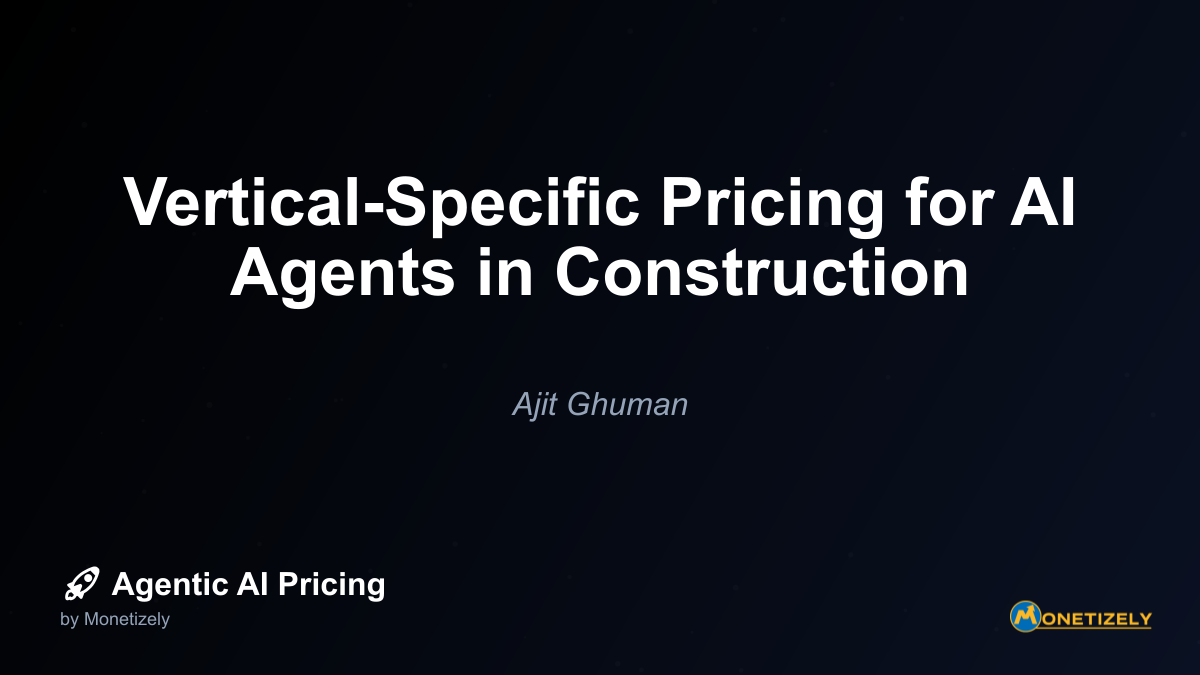· Ajit Ghuman · Industry-Specific · 13 min read
Vertical-Specific Pricing for AI Agents in Real Estate
AI and SaaS Pricing Masterclass
Learn the art of strategic pricing directly from industry experts. Our comprehensive course provides frameworks and methodologies for optimizing your pricing strategy in the evolving AI landscape. Earn a professional certification that can be imported directly to your LinkedIn profile.
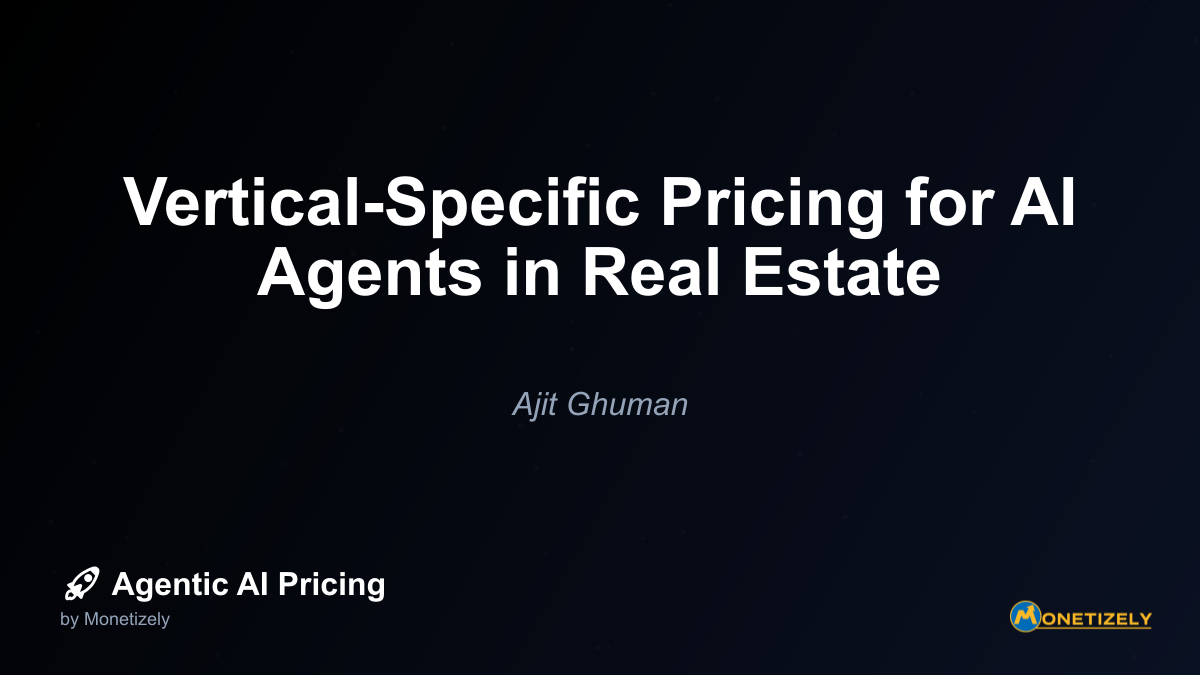
In the rapidly evolving real estate industry, artificial intelligence is revolutionizing how properties are valued, clients are matched with agents, and transactions are processed. This transformation extends to pricing models for AI-powered solutions, creating unique challenges and opportunities for real estate professionals and technology providers alike. Understanding vertical-specific pricing strategies for AI agents in real estate is crucial for maximizing value while addressing the sector’s distinctive needs.
The Real Estate AI Market: Size and Growth Trajectory
The integration of AI in real estate is accelerating at an unprecedented pace. According to recent market analysis, the AI in real estate market is projected to grow robustly, reaching over $1 billion by 2032, with an impressive annual growth rate of approximately 11.5% from a market size of $164.96 billion in 2023. This growth reflects the industry’s recognition of AI’s transformative potential.
PropTech investments reached approximately $630 million by 2023, with over 80% of investors planning to increase their technology spending through 2025. This surge in investment underscores the confidence in AI-driven innovation within the real estate sector and highlights the growing importance of developing appropriate pricing strategies for these technologies.
Key AI Applications in Real Estate
To understand pricing models effectively, we must first examine the primary applications of AI in real estate:
1. Property Valuation and Pricing
AI-powered property valuation tools use sophisticated algorithms to analyze vast datasets including historical sales data, property features, neighborhood trends, and economic indicators. These tools provide more accurate, data-driven property valuations compared to traditional methods.
Advanced AI valuation models incorporate:
- Real-time market data analysis
- Predictive analytics for price forecasting
- Neighborhood-specific trend analysis
- Property feature evaluation and comparison
- Economic indicator integration
The value proposition of these tools centers on increased accuracy, reduced time to generate valuations, and the ability to incorporate a broader range of factors than human appraisers can feasibly consider.
2. Client Matching and Lead Generation
AI systems excel at matching potential buyers with properties that meet their preferences, significantly improving lead quality and conversion rates. These platforms analyze:
- Buyer behavior and search patterns
- Social media data and demographic information
- Historical purchase decisions
- Property viewing history
- Communication preferences
The result is a more efficient matching process that benefits both agents and clients, reducing time wasted on unsuitable properties and improving client satisfaction.
3. Transaction Support and Automation
AI streamlines real estate transactions through:
- Automated document processing and verification
- Smart contract implementation
- Compliance checking and risk assessment
- Closing process automation
- Transaction timeline management
These applications reduce paperwork, accelerate closing times, and enhance transparency throughout the transaction process.
Current Pricing Models for Real Estate AI Tools
Pricing strategies for AI tools in real estate vary depending on the specific application, target user, and value proposition. The most common models include:
1. Subscription-Based Models
Subscription pricing dominates the real estate AI landscape, offering predictable recurring revenue for vendors and manageable costs for users. Key characteristics include:
- Monthly or annual payment structures: Providing flexibility for users while ensuring consistent revenue for providers
- Tiered pricing based on features: Basic, Professional, and Enterprise tiers with increasing capabilities
- User-based scaling: Costs increase with the number of agents or brokers using the system
- Property volume limits: Pricing tiers may restrict the number of properties that can be analyzed or listed
For example, HouseCanary’s CanaryAI offers subscription plans starting at $19/month for real estate agents, providing access to property valuations and in-depth analytics. Higher tiers unlock more sophisticated features and increased usage limits.
2. Transaction-Based Pricing
Some AI tools charge based on completed transactions or specific actions:
- Per-valuation fees: Charging for each property valuation generated
- Success fees: Taking a percentage of completed transactions facilitated by the AI
- Per-document processing fees: Charging for each document analyzed or processed
- Lead conversion fees: Fees based on successful client-property matches
This model aligns costs with actual usage and can be attractive to smaller agencies or those with fluctuating transaction volumes.
3. Freemium Models
Many real estate platforms offer basic AI features for free while charging for premium capabilities:
- Free basic valuations with paid premium insights: Zillow’s Zestimate provides free property valuations but monetizes through advertising and premium agent services
- Limited free searches with paid unlimited access: Allowing a certain number of free AI-powered searches before requiring payment
- Basic features free, advanced analytics paid: Offering fundamental AI capabilities at no cost while charging for sophisticated analysis
Zillow and Redfin exemplify this approach, providing free AI-powered valuations to consumers while monetizing through advertising, lead generation, and premium agent services.
4. Enterprise/Custom Pricing
Larger real estate firms often negotiate custom pricing packages:
- Volume discounts: Reduced per-user or per-property costs for high-volume users
- Custom feature sets: Tailored AI capabilities specific to the firm’s needs
- Integration with existing systems: Special pricing for connecting AI tools with proprietary platforms
- White-label solutions: Custom-branded AI tools with specialized pricing
CoreLogic and other enterprise-focused providers typically offer customized pricing based on the specific needs and scale of their clients.
Case Studies: Real-World AI Pricing in Real Estate
Examining specific companies provides valuable insights into effective pricing strategies:
HouseCanary (CanaryAI)
HouseCanary offers AI-powered property valuations and market analysis with a tiered subscription model:
- Basic subscription: $19/month for individual agents
- Team and brokerage plans: Custom pricing based on user count and feature requirements
- Enterprise solutions: Negotiated pricing for large-scale implementations
The company differentiates its pricing based on the depth of analytics, frequency of updates, and historical data access. Their value proposition centers on accuracy and comprehensive market insights.
Zillow
Zillow employs a multi-faceted approach to monetizing its AI capabilities:
- Free consumer-facing tools: Zestimate property valuation algorithm is provided at no cost
- Advertising revenue: Monetization through targeted ads based on user behavior
- Premium agent services: Charging real estate professionals for enhanced visibility and AI-powered lead generation
- Data licensing: Selling aggregated, anonymized data and insights to enterprise clients
This strategy allows Zillow to build massive consumer engagement while generating revenue from multiple sources.
Compass
Compass integrates AI throughout its platform and bundles pricing within its overall agent offering:
- AI features included in agent platform: AI tools are part of the agent’s overall package
- Commission-based monetization: Agents pay through commission splits rather than direct AI tool fees
- Tiered technology fee structure: Different levels of AI access based on agent productivity and needs
This approach embeds AI costs within the broader agent relationship rather than charging separately for technology.
Redfin
As a tech-forward brokerage, Redfin incorporates AI pricing in its discounted commission model:
- Free consumer-facing valuation tools: Offering AI valuations at no cost to generate leads
- Reduced commission structure: Passing AI efficiency savings to consumers through lower fees
- Bundled technology package: Including AI tools as part of the overall agent technology platform
Redfin leverages AI to reduce operational costs, allowing it to offer lower commissions while maintaining profitability.
Vertical-Specific Pricing Considerations for Real Estate
The real estate sector has unique characteristics that influence optimal AI pricing strategies:
1. High Transaction Value
Real estate involves high-value transactions, which affects willingness to pay for AI tools:
- Value-based pricing opportunities: The potential to charge based on a percentage of property value or transaction size
- ROI justification: Easier to demonstrate return on investment when small improvements affect large transaction values
- Premium pricing potential: Higher willingness to pay for tools that affect significant financial decisions
This characteristic supports higher price points for AI tools that demonstrably improve outcomes in high-value transactions.
2. Cyclical Market Dynamics
Real estate markets experience cyclical patterns that impact pricing strategy:
- Counter-cyclical pricing models: Offering discounts during market downturns to maintain adoption
- Usage-based approaches: Shifting toward transaction-based pricing during slow periods
- Flexible contract terms: Shorter commitment periods during uncertain market conditions
Successful pricing strategies account for these cycles and provide flexibility to adapt to changing market conditions.
3. Fragmented Industry Structure
The real estate industry remains highly fragmented with many independent agents and brokerages:
- Scalable pricing tiers: Creating entry-level options for individual agents
- Team and brokerage packages: Volume discounts for multi-user implementations
- White-label opportunities: Allowing brokerages to offer AI under their own brand
This fragmentation necessitates flexible pricing models that can accommodate various organization sizes and structures.
4. Regulatory Considerations
Real estate is heavily regulated, which impacts AI implementation and pricing:
- Compliance-focused features: Premium pricing for tools that ensure regulatory compliance
- Transparent pricing models: Clear fee structures that satisfy regulatory requirements
- Data privacy considerations: Additional costs for enhanced data security and privacy features
Pricing models must account for the costs of maintaining regulatory compliance and managing associated risks.
5. Commission Structure Evolution
Traditional commission structures are evolving, partly due to AI’s impact:
- Performance-based pricing: Aligning AI costs with transaction success
- Commission-sharing models: Integrating AI fees with existing commission structures
- Efficiency-based pricing: Charging based on time saved or process improvements
As AI transforms how agents work, pricing models are adapting to align with new commission paradigms.
Pricing Strategies for Property Valuation AI
Property valuation represents one of the most mature AI applications in real estate, with several distinct pricing approaches:
1. Accuracy-Tiered Pricing
This model prices based on the precision and depth of valuation insights:
- Basic valuation tier: Standard automated valuation model (AVM) results with limited supporting data
- Enhanced accuracy tier: More sophisticated algorithms with additional data sources and higher confidence scores
- Premium analysis tier: Comprehensive valuation with detailed market comparables, trend analysis, and confidence metrics
This approach allows users to pay only for the level of accuracy they require for specific use cases.
2. Volume-Based Pricing
Scaling costs based on the number of valuations performed:
- Pay-per-valuation: Charging a fee for each property analyzed
- Bulk discounts: Reduced per-valuation costs for higher volumes
- Unlimited plans: Flat fees for unlimited valuations within defined parameters
This model works well for users with varying needs, from occasional valuations to high-volume operations.
3. Market Segment Differentiation
Pricing varies based on the property type or market segment:
- Residential property pricing: Lower price points for standard residential valuations
- Commercial property pricing: Premium fees for more complex commercial property analysis
- Luxury market pricing: Higher rates for high-value property valuation with specialized algorithms
This approach recognizes the different complexity levels and value propositions across property segments.
4. Data Integration Pricing
Costs vary based on data sources incorporated into the valuation:
- Standard data tier: Using publicly available property and transaction data
- Enhanced data tier: Incorporating premium data sources like detailed property features
- Comprehensive data tier: Including alternative data such as neighborhood amenities, school ratings, and environmental factors
This strategy allows users to select and pay for only the data sources relevant to their valuation needs.
Pricing Strategies for Client Matching AI
AI-powered client matching tools require different pricing approaches:
1. Lead Quality-Based Pricing
Pricing based on the quality and conversion potential of leads:
- Basic lead generation: Standard matching with limited qualification
- Qualified lead pricing: Higher fees for leads with stronger buying signals
- Premium match pricing: Top-tier pricing for high-probability matches with detailed client insights
This model aligns costs with the actual value of client matches rather than raw volume.
2. Success-Based Pricing
Charging based on successful outcomes:
- Pay-per-meeting: Fees for client meetings arranged through the AI
- Transaction success fees: Payments only when matches result in completed transactions
- Hybrid models: Combining base subscription with success bonuses
This approach reduces upfront costs and aligns vendor incentives with client success.
3. Integration-Based Pricing
Pricing varies based on integration with existing CRM and marketing systems:
- Standalone tool pricing: Higher costs for independent systems
- CRM integration tier: Moderate pricing for tools that connect with existing CRMs
- Full-stack integration: Premium pricing for seamless integration across all client systems
This strategy recognizes the added value of unified workflows and data sharing.
4. Exclusivity Pricing
Charging based on geographic or market segment exclusivity:
- Shared market access: Lower pricing for non-exclusive client matching
- Limited-sharing tier: Moderate pricing for sharing with fewer competitors
- Exclusive territory rights: Premium pricing for exclusive access to matches in specific areas
This model is particularly relevant in competitive markets where exclusive leads command premium prices.
Pricing Strategies for Transaction Support AI
AI tools that support real estate transactions typically employ these pricing approaches:
1. Transaction Volume Pricing
Scaling costs based on the number of transactions processed:
- Per-transaction fees: Fixed cost per transaction supported
- Tiered transaction volume: Decreasing per-transaction costs at higher volumes
- Unlimited transaction plans: Flat fees for unlimited transaction support
This model directly links costs to transaction activity, making it easy to calculate ROI.
2. Feature-Based Pricing
Charging based on specific transaction support features utilized:
- Basic document processing: Lower pricing for standard document handling
- Compliance verification tier: Additional fees for regulatory compliance features
- Full transaction automation: Premium pricing for end-to-end transaction support
This approach allows users to pay only for the specific capabilities they need.
3. Time-Saving Pricing
Basing costs on the time saved in the transaction process:
- Efficiency metrics pricing: Fees calculated based on documented time savings
- Acceleration bonuses: Premium charges for transactions completed faster than benchmarks
- Process improvement pricing: Costs linked to specific workflow improvements
This model directly ties pricing to one of the most tangible benefits of AI: time efficiency.
4. Risk Reduction Pricing
Charging based on risk mitigation capabilities:
- Standard risk assessment: Basic pricing for transaction risk evaluation
- Enhanced compliance tier: Higher fees for advanced regulatory compliance features
- Comprehensive risk management: Premium pricing for full risk mitigation capabilities
This approach is particularly valuable in complex transactions with significant regulatory requirements.
Implementation Challenges and ROI Considerations
Implementing AI pricing models in real estate faces several significant challenges:
1. Implementation Costs
The upfront costs of AI implementation can be substantial:
- Software licensing and customization: Initial expenses for AI platforms
- Data collection and preparation: Costs for gathering and cleaning necessary data
- Infrastructure upgrades: Potential hardware and network improvements
- Training and change management: Expenses related to user adoption
These costs must be factored into pricing models to ensure profitability while remaining competitive.
2. Technical Integration Complexity
Integrating AI with existing systems presents technical challenges:
- Legacy system compatibility: Difficulties connecting with older real estate platforms
- Data standardization issues: Challenges with inconsistent data formats
- API limitations: Constraints in connecting with third-party systems
- Workflow disruption: Potential business interruptions during implementation
Successful pricing strategies account for these integration challenges and may offer tiered pricing based on integration complexity.
3. ROI Measurement Challenges
Quantifying the return on investment for AI tools can be difficult:
- Attribution problems: Difficulty isolating AI’s specific contribution to outcomes
- Long-term value calculation: Challenges in measuring benefits that accrue over time
- Indirect benefit quantification: Struggles to assign value to improved client experience
- Benchmark establishment: Lack of industry standards for comparison
Effective pricing models address these challenges by focusing on measurable outcomes and providing clear ROI frameworks.
4. Best Practices for Implementation
Successful implementation of AI pricing in real estate follows these principles:
- Phased approach: Starting with focused use cases before expanding
- Clear value metrics: Establishing specific, measurable success criteria
- Transparent pricing communication: Clearly explaining the value proposition
- Flexible adjustment mechanisms: Building in the ability to refine pricing based on results
These practices help overcome implementation challenges and maximize the effectiveness of pricing strategies.
Future Trends in AI Pricing for Real Estate
Several emerging trends will shape the future of AI pricing in real estate:
1. Dynamic, Real-Time Pricing Models
AI-powered pricing will become increasingly responsive to market conditions:
- Automatic price adjustments: Fees that change based on market activity
- Real-time value tracking: Pricing tied to continuously updated property valuations
- Demand-based pricing: Costs that fluctuate with market demand for specific AI services
This trend reflects the growing sophistication of AI systems and their ability to adapt to changing conditions.
2. Unbundled AI Services
Moving from all-in-one platforms to à la carte capabilities:
- Microservice pricing: Charging separately for specific AI functions
- Custom AI packages: Allowing users to build personalized feature sets
- Pay-for-performance options: Selecting and paying only for services that deliver results
This approach provides greater flexibility and allows users to optimize their AI investments.
3. Integration with Blockchain and Smart Contracts
Combining AI with blockchain technology to transform transaction processes:
- Automated payment triggers: Fees automatically processed when predefined conditions are met
- Smart contract integration: Pricing embedded within automated transaction
Co-Founder & CEO
Ajit is the author of Price To Scale, a top book on SaaS Pricing and is the Founder of Monetizely. Ajit has led and worked in pricing and product marketing at firms like Twilio, Narvar and Medallia. His work has been featured in Forbes and VentureBeat. Ajit regularly consults with software companies from Seed stage to post-IPO on pricing strategy. Ajit is also a highly-rated co-instructor for 'The Art of SaaS Pricing and Monetization' on Maven.
Pricing Strategy Audit
Let our experts analyze your current pricing strategy and identify opportunities for improvement. Our data-driven assessment will help you unlock untapped revenue potential and optimize your AI pricing approach.

